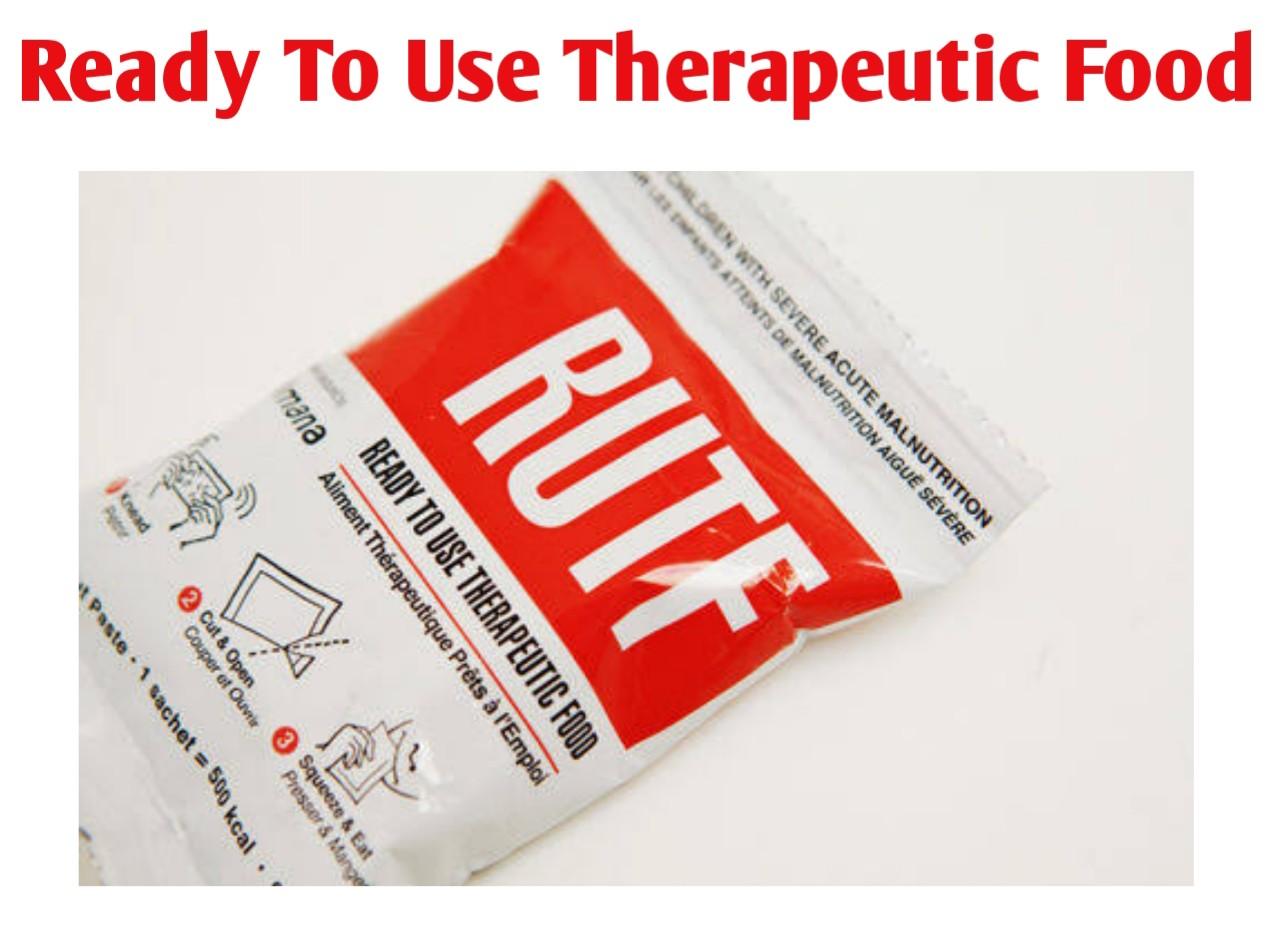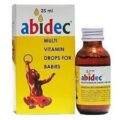
Ready-to-Use Therapeutic Food or RUTF is a vitamin and mineral fortified peanut paste mixed with dry milk products. They are energy-dense, micronutrient enhanced pastes used in therapeutic feeding. These soft foods are a homogenous mix of lipid-rich foods, with a nutritional profile similar to the World Health Organization-recommended therapeutic milk formula used for inpatient therapeutic feeding programmes.
RUTF is not a panacea for all forms of severe acute malnutrition in children. Those suffering from medical complications, including loss of appetite, severe oedema, anorexia, high fever or severe dehydration require inpatient treatment with specialized therapeutic milk and round-the-clock medical care.
All infants less than 6 months old suffering from the condition should be referred to a stabilization centre, which is often hospital-based, and should receive breastfeeding support. Under medical supervision, diluted therapeutic milk or special ready-to-use infant formula (RUIF) may be considered appropriate in extreme cases, such as for maternal orphan infants under six months suffering from severe acute malnutrition, infants whose mothers cannot breastfeed, or with HIV positive mothers who decide not to breastfeed. The WHO/UNICEF/WFP Specifications for RUTF is provided below:
|
|
|
| Moisture content | 2.5% maximum |
| Energy | 520-550 Kcal/100g |
| Proteins | 10 to 12 % total energy |
| Lipids | 45 to 60 % total energy |
| Sodium | 290 mg/100g maximum |
| Potassium | 1100 to 1400 mg/100g |
| Calcium | 300 to 600 mg/100g |
| Phosphorus (excluding phytate) | 300 to 600 mg/100g |
| Magnesium | 80 to 140 mg/100g |
| Iron | 10 to 14 mg/100g |
| Zinc | 11 to 14 mg/100g |
| Copper | 1.4 to 1.8 mg/100g |
| Selenium | 20 to 40 µg |
| Iodine | 70 to 140 µg/100g |
| Vitamin A | 0.8 to 1.1 mg/100g |
| Vitamin D | 15 to 20 µg/100g |
| Vitamin E | 20 mg/100g minimum |
| Vitamin K | 15 to 30 µg/100g |
| Vitamin B1 | 0.5 mg/100g minimum |
| Vitamin B2 | 1.6 mg/100g minimum |
| Vitamin C | 50 mg/100g minimum |
| Vitamin B6 | 0.6 mg/100g minimum |
| Vitamin B12 | 1.6 µg/100g minimum |
| Folic acid | 200 µg/100g minimum |
| Niacin | 5 mg/100g minimum |
| Pantothenic acid | 3 mg/100g minimum |
| Biotin | 60 µg/100g minimum |
| n-6 fatty acids | 3% to 10% of total energy |
| n-3 fatty acids | 0.3 to 2.5% of total energy |
SAM is a condition that affects children from the ages of six to 59 months that have an extremely low weight for height measure, visible severe wasting and/or the presence of edema. Around 20 million children worldwide are estimated to be suffering from this condition, of which only approximately 10 -15 per cent currently receive treatment using RUTF. Severe acute malnutrition is a major killer of children under five, accounting for approximately 1 million deaths annually. Although most RUTFs are currently manufactured in and imported from advanced economies, the technology to produce them has been introduced in developing countries with minimal industrial infrastructure. By 2012, African-produced RUTF represented 45% of the total purchased by UNICEF. This home-based treatment for severe acute malnutrition has revolutionized the treatment of severe malnutrition providing foods that are safe to use at home and ensure rapid weight gain in severely malnourished children.
RUTF was first introduced in situations of humanitarian emergencies during the early 2000s when access was a considerable barrier to expanding coverage of inpatient treatment. Its application within community management of acute malnutrition (CMAM) – an inter-agency strategy supported by WHO, the World Food Programme, the UN Standing Committee on Nutrition and UNICEF has resulted in a sharp rise in programme coverage and children treated successfully. In Ethiopia alone, there has been a twelve-fold increase in the number of children treated in the past nine years. Currently, 61 countries have some form of treatment for severe acute malnutrition with
The standard dose of RUTF
The standard dose of RUTF is adjusted according to the weight of the child under treatment. It can be consumed in the home at any time under minimal supervision until the child has gained adequate weight. Because RUTF does not contain water, children should also be offered safe drinking water to consume at will.
They also require a short course of basic oral medication to treat any infections and for deworming, vitamin A supplementation and folic acid. Health workers should also provide follow up care in the form of the next supply of RUTF on a weekly or biweekly basis and should monitor the child’s condition.
An average full course of treatment for a child amounts to around 10-15 kilogrammes of RUTF over a 6-8 week period, which is approximately one carton of RUTF (150 sachets). In community-based management of acute malnutrition (CMAM), RUTF should always be dispensed as a part of a treatment protocol that provides a full medical consultation, in conjunction with infant feeding counselling and provision of routine medical treatment, including essential drugs, and referral to inpatient care when necessary. In UNICEF-supported CMAM programmes, clean water is provided at every site and children drink water while treated. Additionally, appetite tests are conducted and a full intake questionnaire undertaken that includes medical history, dietary history and household food security assessment.
How long does a child need to be treated by RUTF?
Typically, a child needs to eat 10-15kg of RUTF over a period of six to eight weeks. According to the American Journal of Clinical Nutrition, 98% of children treated with RUTF were well nourished after six months and 96% were well nourished after a year. The first 1,000 days of a child’s life are vital and can determine that child’s full growth prospects. That is why we must treat these starving children today.
Local production of RUTF
RUTF is easy to make, there are RUTF food examples in many countries. The four basic ingredients in RUTF are:
- Sugar
- Dried Skimmed Milk
- Oil
- Vitamin and Mineral Supplement (CMV)
In addition, up to 25% of a product’s weight can come from oil seeds, groundnuts or cereals like oats.
As well as containing the necessary proteins, energy and micronutrients, RUTF should also have the following attributes:
- Taste and texture suitable for young children
- No need for cooking before consumption
- Resistant to contamination by micro-organisms and long shelf-life without sophisticated packaging. Product should be oil-based
Advantages of RUTF
Does Not Require Water to Make
The advantage of RUTF is that it is a ready-to-use paste that does not need to be mixed with water, thereby avoiding the risk of bacterial proliferation in case of accidental contamination.
Highly Nutritious
The product which is based on peanut butter mixed with dried skimmed milk and vitamins and minerals can be consumed directly by the child and provides sufficient nutrient intake for complete recovery.
Storage and Availability
It can be stored for three to four months without refrigeration, even at tropical temperatures. Local production of RUTF paste is already under way in several countries including Congo, Ethiopia, Malawi and Niger.




